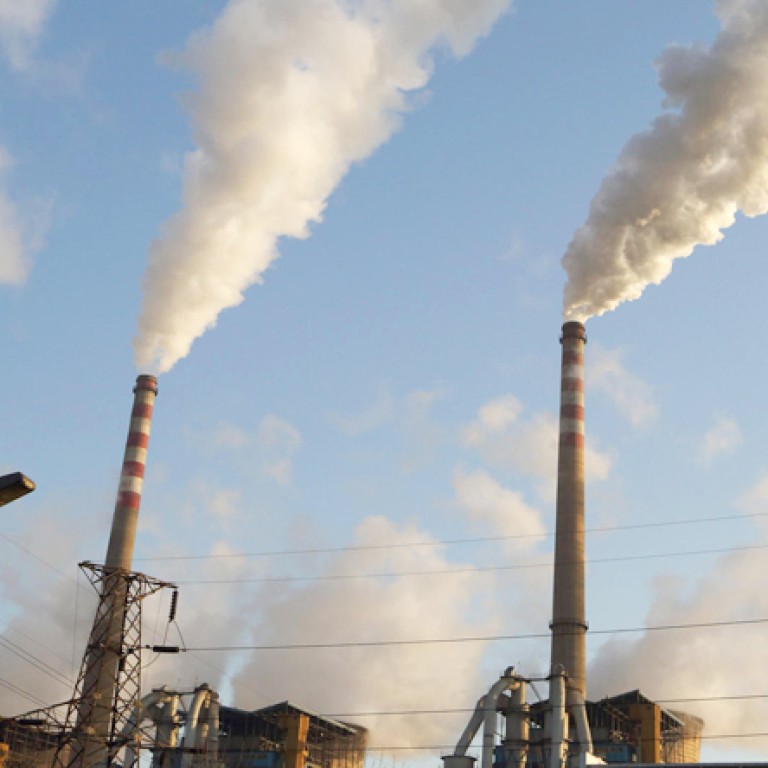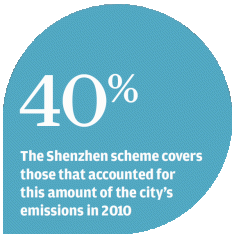
Lessons from Shenzhen carbon exchange will help others flourish
Experiences of China's first carbon trading scheme over its initial four months inform preparations for exchanges in other cities
More than four months into its operation, China's first carbon emissions exchange in Shenzhen is seeing thin trading volumes and sharp price fluctuations.

The Shenzhen Emissions Exchange in June became the first of seven pilot carbon-trading schemes to go online.
It covers 635 industrial firms and 197 government buildings, which accounted for about 40 per cent of the city's total emissions in 2010.
The municipal government has given annual emission quotas to each firm. Their performance will be reviewed every 12 months and their allotments adjusted accordingly. They have a combined quota of 100 million tonnes of carbon, which covers their operations from this year to 2015.
The companies, as well as individual investors, can buy carbon credits by the tonne. The goal is to reduce pollution by offering polluters economic incentives to reduce emissions.
In the first 100 days of the exchange's operation, 113,000 tonnes were traded in 185 deals, worth a total of 7.25 million yuan (HK$9.16 million). Prices reached as high as 143.99 yuan per tonne last month, more than five times the price in the first deal in June.
But such deals were largely entered into by individual speculators. The trading volumes were often quite small - only single-digit in some cases - although individual deals accounted for 40 per cent of all trades, the exchange said.
Industry experts said the small volumes meant it was too early to draw any meaningful conclusions about the scheme or its impact.
Tang Renhu, director of SinoCarbon Innovation and Investment, a consultancy based in Beijing, said the trading so far, especially the deals between individual accounts at high prices, could not be counted as "carbon trading in its real sense".
The appropriate price should be determined through deals conducted by firms tied to the scheme, Tang said.
On the Shenzhen exchange, the price reached through company deals stood at between 60 and 80 yuan per tonne, which was "not a very bad start", he said.
reported that some of the firms had no clear idea about the scheme and had only opened their accounts after being requested to do so by the government.
Tang's company surveyed about 120 firms in the Shenzhen scheme. He found that about 80 per cent had adopted a "wait-and-see" attitude. They were unsure whether to sell or buy quotas at this stage. "Only those enterprises with some knowledge and expertise are willing to experiment," he said.
Determining the right level for the emission caps and allocating allowances to firms are critical initial steps for the eventual success of the national carbon market. Most participating companies may not be able to meet their targets if the caps are too stringent. If they are too loose, the firms will not have an incentive to cut emissions and prices will drop.
Local legislation requires firms whose emissions exceed their quota to buy extra rights from those who come under their limit. Otherwise, they will be liable to penalties three times the market price of the quotas.
Making things more complicated, the allowances on the Shenzhen market are calculated based not only on companies' carbon emission levels but also their future industrial output.
China has not agreed to binding caps on carbon emissions but it is committed to reducing its carbon intensity by 40 to 45 per cent by 2020 from 2005 levels.
Carbon intensity measures the volume of carbon dioxide emitted in the production of each unit of gross domestic product output.
The carbon intensity of the firms covered by the Shenzhen scheme is expected to drop by 37 per cent by 2015 from 2010 levels, exceeding the 21 per cent citywide target.
Tang and other industry insiders expect more trading before June next year, when the Shenzhen government will review whether the enterprises have met their emission reduction targets and allocate quotas for next year.
Preparations to unveil three other exchanges - in Beijing, Shanghai and for Guangdong province - are under way, with some expected to be launched by the end of the year. There will be some differences between their trading mechanisms to allow for further experimentation.
For instance, Guangdong is planning to allocate 95 per cent of quotas free of charge and auction the remaining 5 per cent, according to the provincial development and reform commission.
But the other carbon markets - in Tianjin , Chongqing and Hubei - are unlikely to launch any time soon, according to a recent survey of financiers, regulators, academics and industry players conducted by the Australian National University- and Beijing-based China Carbon Forum.
Even without them, a unified national market could still be established sometime between 2016 and 2020, Tang said.
"There is no need to wait for all of the seven [markets] to succeed, and some of them might even turn out to fail," he said. "But learning lessons is the purpose of the pilot programme."
Progress in the Shenzhen exchange and preparatory work for the three others in the pipeline have sent a clear signal that China is determined to regulate its carbon emissions, an unprecedented move for the world's top carbon polluter.
"Though a national carbon cap is still absent, the carbon price from such pilot trading schemes already serves to warn the industrial sector that emitting carbon dioxide will no longer be free," he said.
The industry insiders surveyed expected the price of carbon to rise from 32 yuan per tonne in 2014 to 53 yuan per tonne in 2018.
Some 20 per cent of respondents estimated the carbon price would surpass 80 yuan in 2018. Dimitri de Boer of the China Carbon Forum said that would have an impact on investment decisions.

